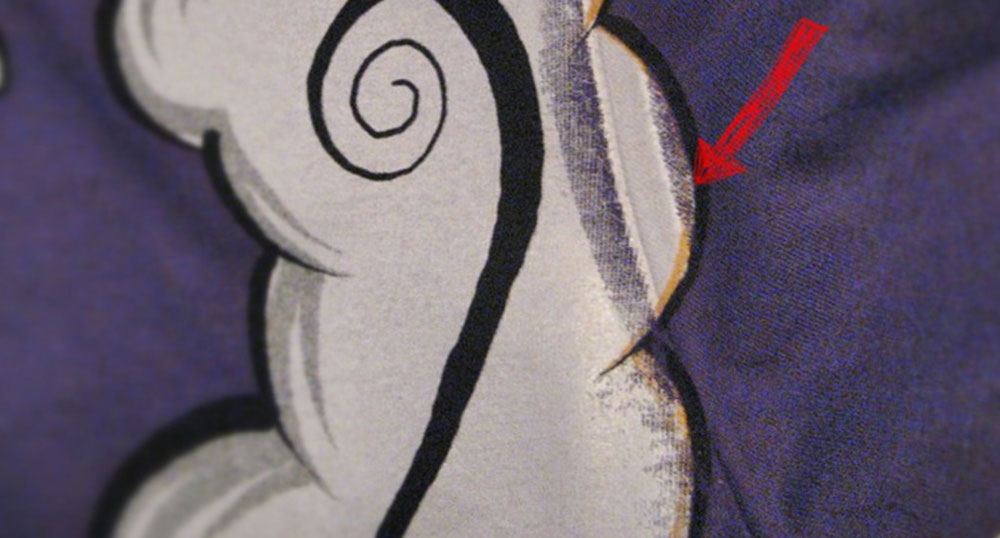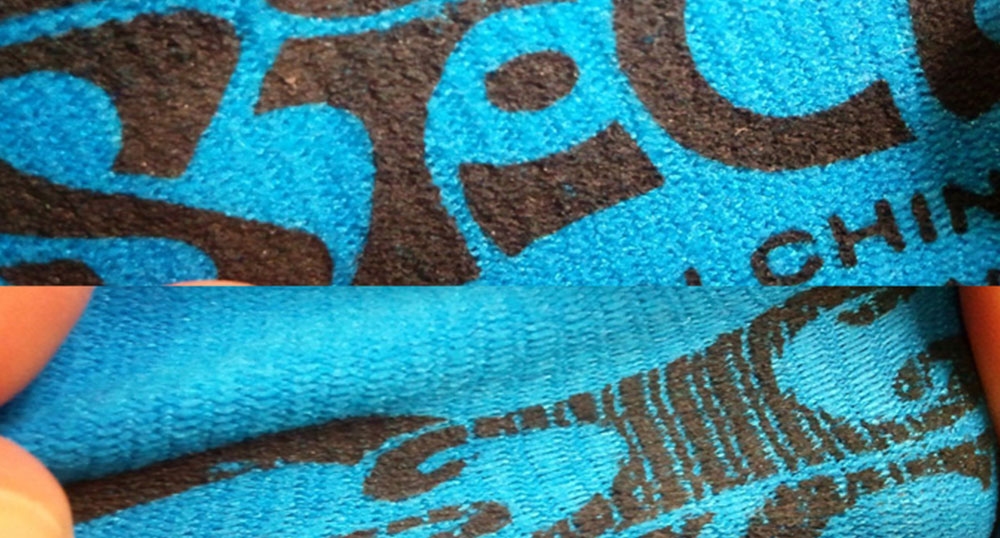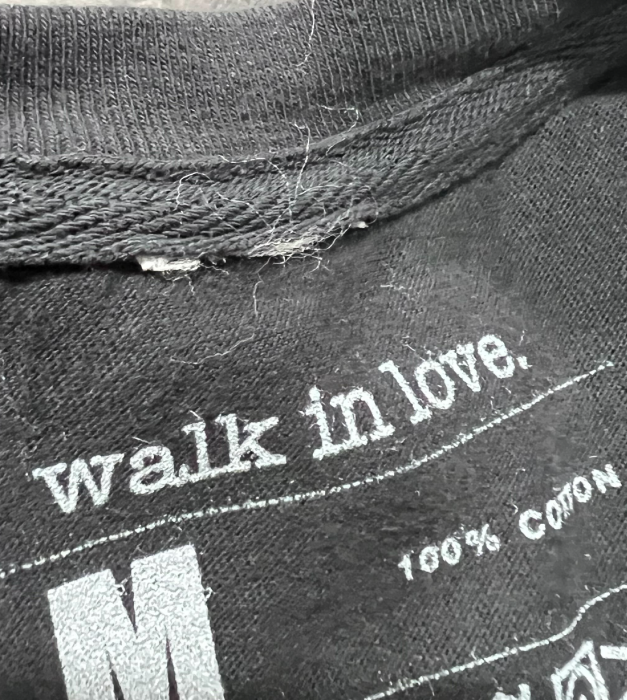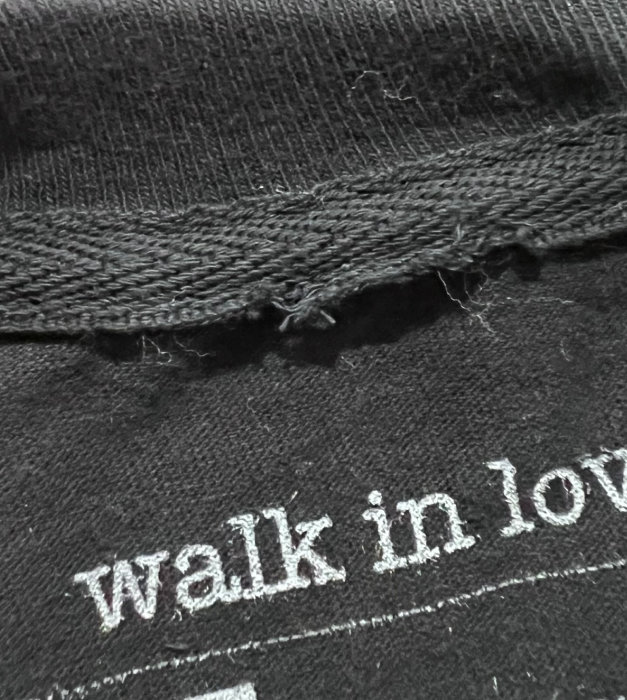Why Not To Print Over Seams, Pockets or Zippers
To get the best quality print when screen printing, we need as flat of a surface as possible between the pallet (that the garment lays on) and the screen (that holds your design). The fronts and backs of t-shirts are consistently smooth and the same thickness, which allows us to get a perfect print every time. However, when you print over a seam, pocket or zipper, it creates an inconsistency, because these are thicker portions of the garment. When you print over these portions of the garments, it creates a gap in the print where the ink from the screen does not touch the shirt due to the ridge caused by the seam. Here is an example:
We do our absolute best to give you the highest quality print possible, but when a print goes over the seams, we cannot accept responsibility for any negative effects caused by this issue.
Note: For screen printed hooded sweatshirts, we do have special pallets that have indentations for the zipper and pocket seams but not every sweatshirt is exactly the same.
Why Not To Print On Ribbed Garments
Ribbed garments provide the best form fit of all blank shirts as they stretch to meet the size of the individual wearing them. This is great the for final consumer but makes screen printing on the ribbed shirt a problem. When you pull a ribbed garment onto the press, it is not stretched out, so the ink only goes on the top of the ribs. Then, when the shirt is put on, the ink pulls apart, exposing a gap between the ribs that is not printed. We can apply more pressure on the press to try to force the ink into the gaps, but this limits the amount of detail that is actually shown on the garment. Because of these issues, we strongly suggest that you do not print on ribbed garments. Here is an example:
What Garments Don't De-Tag Well
Most clothing lines remove the manufacturer's tags from shirts to screen print their logo and information into the shirt, branding it as their own. Most manufacturers understand this and make their tags easy to remove. However, some brands have tags that are sewn into the seam, rather than under the seam which makes them difficult to de-tag. If a garment doesn’t have a tear-away tag, and you’d like the original tags removed, then the they will need to be cut (which can result in remnants or holes left behind- see image below). With this in mind, these are garments and brands to be aware of:
- Alternative Apparel Garments
- American Apparel 2408 Tanks
- American Apparel 2456 V-Necks
- Comfort Color Garments
- Fleece Garments
- Tultex 0213
What Shirts Don't Work Well With Jumbo Prints
Jumbo prints account for approximately 50% of all orders placed at our shop. People want as big of a print as possible. With standard unisex or mens tees, this is typically not a problem. However, some shirts have issues when printing Jumbo:
- Tank Tops: Most tank tops are low cut at both the neckline and the sleeves. Printing jumbo prints on these garments can cause print defects from printing over the seams.
- V-Necks: The neck line of the v-neck may cut into the design. Please take this into account when you are designing your shirt.
- Girls Tees: Jumbo pallets are wider than most girls tees. In order to get the girls tee onto the press, it has to be stretched. This can cause several issues: possible ripped shirts, loss of form from stretching past normal means, a distorted image due to stretching the shirt, and the design being cut off the bottom/sides of the shirt.
Note: Any print that goes over a seam will result in imperfections in the print. (Some customers find this effect desirable, but we discourage it and will not be held responsible for misprints).
What Garments Don't Show Detail Well
With advancements in screen printing (including high mesh count screens and specialty presses) we can recreate a level of detail with t-shirts that was previously unattainable just 5-10 years ago. However, due to the way some garments are constructed, they will not work well with detail. The following is a list of those garments:
- Ribbed Garments
- Canvas Material (Aprons, Bags, etc.)
- Burnout Tees
- Pique Polos
These items do not work well with screen printing detail because they are not smooth like standard t-shirts.
Why Isn't Every Garment Perfect
Contrary to popular belief, most t-shirts are not made by giant machines, they're sewn together in facilities by hand. Check out the following video series made by NPR following the creation of a t-shirt:
Due to the human element, not every shirt will be 100% correct. You may have two large shirts that are both the same style but one may have a slightly different cut. Since Threadbird does not make the shirts, we cannot guarantee that every garment will be made correctly. We do our best to catch these issues before sending the shirts to you, but sometimes these defects can slip through our hands. You may find a hole in your t-shirt or you may see a seam that isn't sewn up the way it should be. If you find any items with holes or rips in them, please let us know and we will work with you on refunding you for the defective items. However, we cannot give refunds for any shirts due to their fit.
What Issues Will Arise When Printing Hoodies
Hoodies are one of the more difficult garments to print on, but they are also one of the best selling items during the winter. The following are a few issues to be aware of when printing hoodies:
- Double lined hoodies can only print 1 color ink and no underbase. They slide around on the press so we cannot accurately register multiple colors.
- Pockets on hoods have to be glued down to print over them. Because of this, when you receive your garments, they may still have some of the glue spray in the pockets. This should wash out after one wash.
- Prints on the hood itself vary based on what brand of sweatshirt you are printing on. We may have to heat press the design onto the hood if it is double lined. Only single lined sweatshirts work with hood prints.
- We do have special pallets that have indentations for the zipper and pocket seams, but not every sweatshirt is exactly the same. When you print over these portions of garments, it creates a gap in the print where the ink in the screen does not hit the shirt due to the ridge caused by the seam. For this reason, we do not recommend printing over-the-zipper.
- When you print over the seams, it can throw the registration off. You may see white poking out from under the design.
- Hoodies are made with thick fabric and soak up a lot of ink. The color of the sweatshirt will often times influence the ink colors. To get the highest quality print when going over zippers &/or pockets, we recommend using a 100% cotton or 80/20 blend hoodie and using all discharge colors without an underbase.
- When printing hoodies, we cannot mix them with regular t-shirts on an order because they require a different set of equipment and settings on the printing press. If you would like to order the same design on both t-shirts and hoodies, we will need to set up your order as two separate designs.
What to do Differently on Tri-Blend Tees
Flash units on presses burn the tri-blend material, so tri-blend shirts are not underbased. Please take this into account when you order them. Without an underbase, tri-blend tees will have a faded/vintage look, which is what the shirts were intended for. When printing tri-blends we always recommend using either 100% waterbase ink or a waterbase discharge ink to get the softest print possible. If you don't use waterbase ink, your only real option is plasitsol ink. Threadbird recommends that you only opt for a tri-blend tee if you are looking for a soft shirt with a soft print.
Why to Send Extra Hem Tags or Hang Tags
We do our absolute best to treat every shirt with the utmost care, including any additional items you send us, like hem tags and hang tags. When providing hem tags and hang tags, we strongly recommend that you send at least 10% extra when you place your order. During the process of sewing in the tags, they can rip on the machine and if we don't have extras, we cannot ensure that all shirts will be tagged. Threadbird is not responsible for shirts that are not tagged if extras were not provided. If a tag is misplaced or damaged in the process, Threadbird will send the shirt untagged but will not refund the cost to sew the tag into the shirt that is missing a tag.



